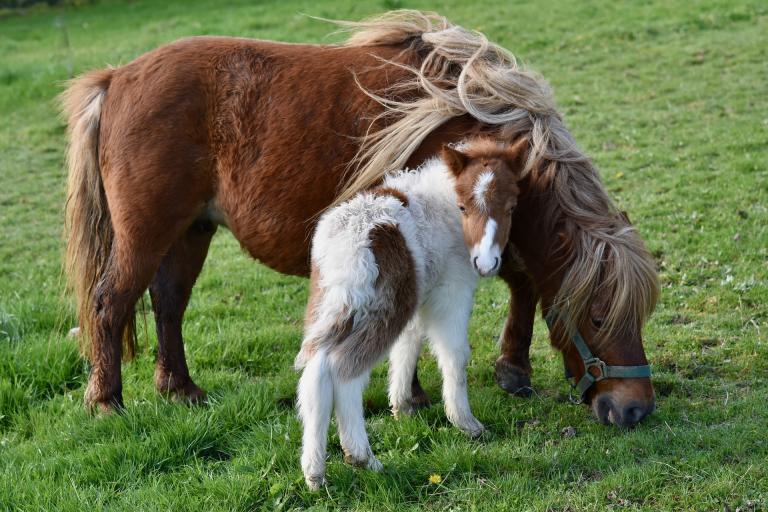Skeletal Atavism (SA horse)
In skeletal atavism (SA), deformation of the legs occurs due to the formation of an additional bone, which was still present in the ancestors. However, the body of the modern horse is no longer designed to accommodate both bones, and health problems and severe pain result.
The disease occurs in Miniature Horses and Shetland Ponies. It is inherited autosomal recessively.
Symptoms
- Malformation of legs and joints
- Short, splayed legs
- Progressive lameness
- Impaired movement
- Strong pain
General Information
- The term “atavism” originates from the latin word “atavus” (“ancestor”) and refers generally to the reoccurrence of ancient traits in recent species.
- During the evolution of horses, the ulna and fibula fused, and modern horses have only one bone instead of two bones.
- Skeletal atavism results in development of both fully sized bones again and causes severe deformation of bones and joints.
- This disease leads to severe pain in the affected ponies and Miniature horses and hence to euthanasia due to poor quality of life.
- Two mutations in the SHOX gene cause SA. Ponies may have both mutations and/or variants in the ACAN gene causative for the ACAN-dwarfism.
Please be aware that by the conditions of the Skeletal Atavism (SA) patent license, the identity of the horse must be verified for Generatio to perform the SA test. Samples may be collected by a veterinarian or studbook representative who can confirm the animal’s microchip identification.
Generatio holds an unlimited license to the Skeletal Atavism TestTM from Capilet Genetics.
Test Information
This test detects both deletions in the SHOX gene.
Genotype and Lab Report
Inheritance: autosomal-recessive
→ Only animals with two copies of the varaint (sa/sa) are affected. Animals with only one copy are clinically normal carriers (N/sa).
Genotype
N/N = normal
The horse has no copies of the genetic variant causative for SA and therefore cannot pass it on to its offspring.
N/sa = a carrier
The horse is clinically healthy. The variant will be passed on to its offspring with a probability of 50%.
sa/sa = affected
The variant will be passed on to all offspring. All offspring will be carriers (N/sa).
Recommendations
- Carriers may be bred to normal animals (N/sa x N/N) without any risk of producing affected offspring. The offspring should also be tested before breeding to determine if they are carriers or normal.
- Breeding two carriers (N/sa x N/sa) is not recommended due to the possibility of 25% of the offspring being affected.
- Affected animals (sa/sa) should not be used for breeding.
Literature
Rafati, N., Andersson, L.S., Mikko, S., Feng, C., Raudsepp, T., Pettersson, J., Janecka, J., Wattle, O., Ameur, A., Thyreen, G., Eberth, J., Huddleston, J., Malig, M., Bailey, E., Eichler, E.E., Dalin, G., Chowdary, B., Anderssson, L., Lindgren, G., Rubin, C.J. : Large Deletions at the SHOX Locus in the Pseudoautosomal Region Are Associated with Skeletal Atavism in Shetland Ponies. G3 (Bethesda) :, 2016. Pubmed reference: 27207956. DOI: 10.1534/g3.116.029645.
Tyson, R., Graham, J.P., Colahan, P.T., Berry, C.R. : Skeletal atavism in a miniature horse. Vet Radiol Ultrasound 45:315-7, 2004. Pubmed reference: 15373256.
Further information is available at Online Mendelian Inheritance in Animals.

